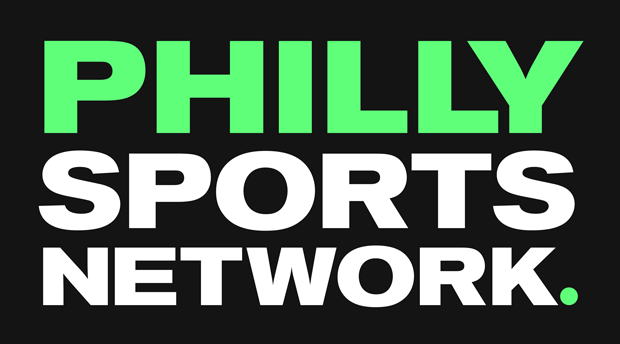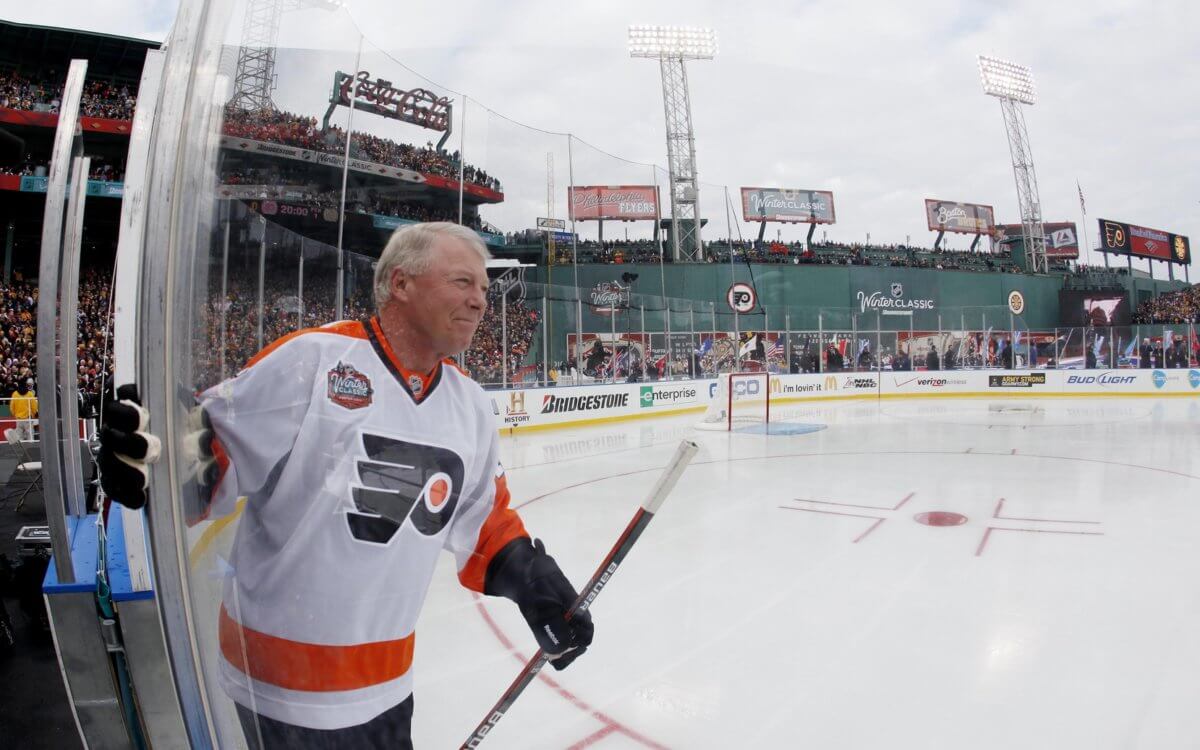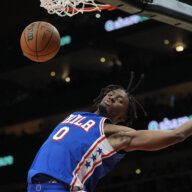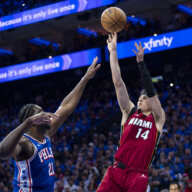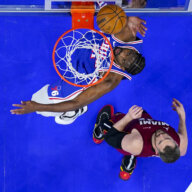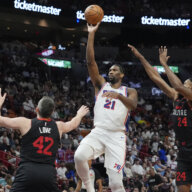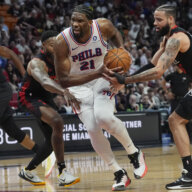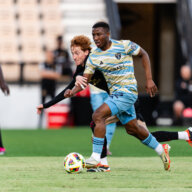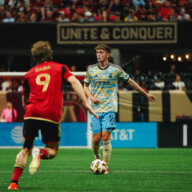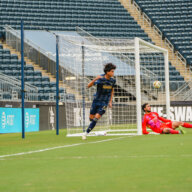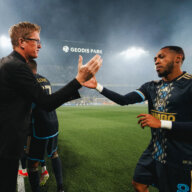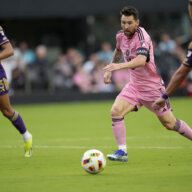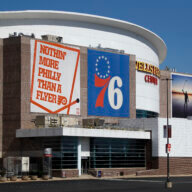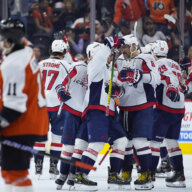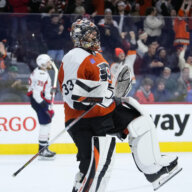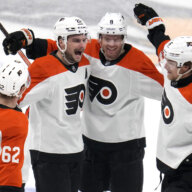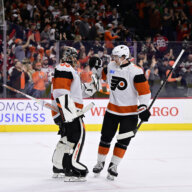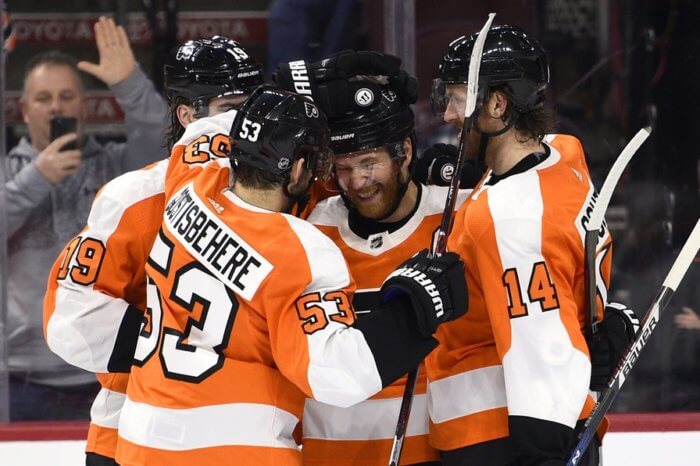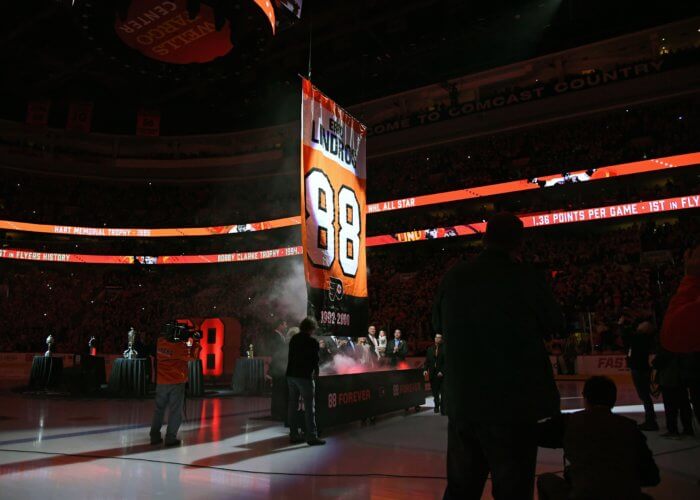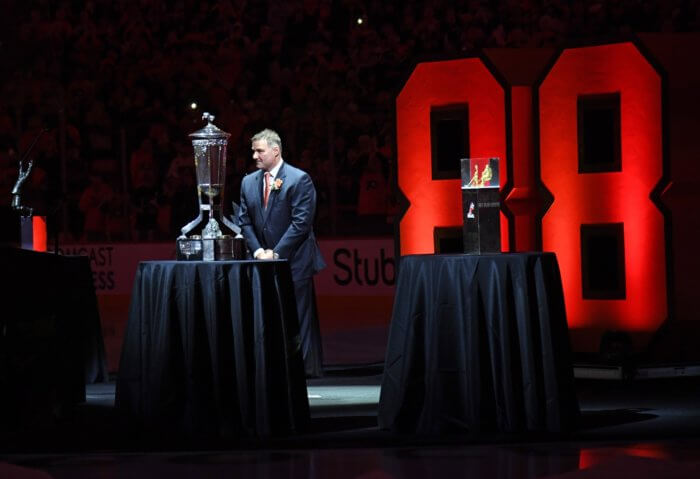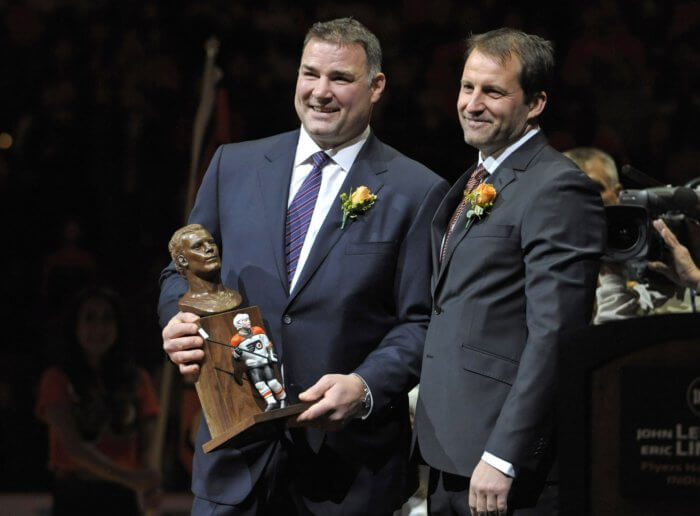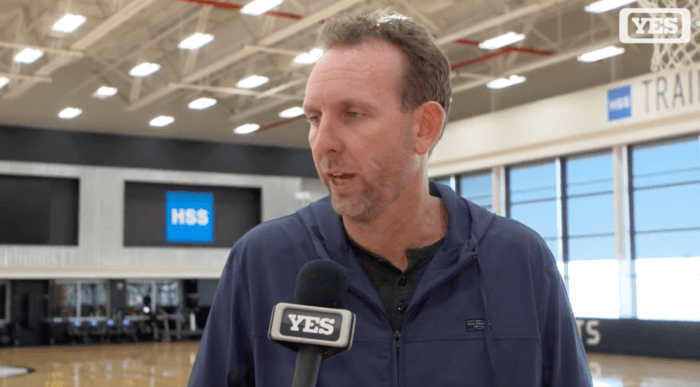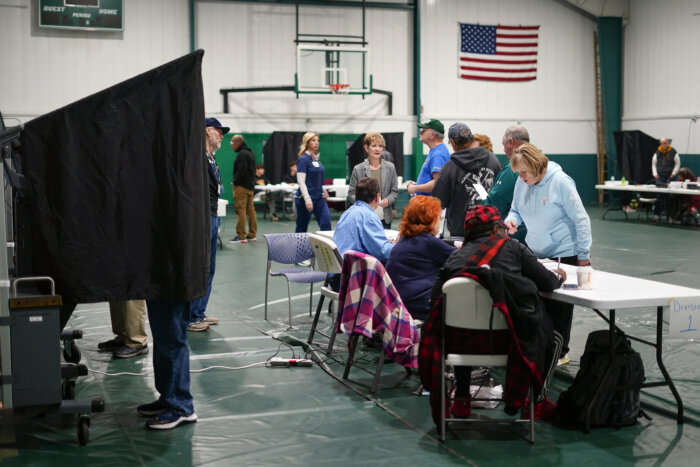This is a great time to be a Flyers fan. The top brass have turned this organization into a prospect juggernaut, as they are moving closer towards a parade down Broad Street. However, the orange and black are so rich with history we can never forget their past. For instance, the iconic commentator Gene Hart’s call in the 1973-74 Stanley Cup Finals at the end of game 6, “Ladies and gentleman, the Flyers are going to win the Stanley Cup! The Flyers win the Stanley Cup! The Flyers have won the Stanley Cup.” It still sends some Flyers fans some chills throughout their bodies. To Hart’s call against the Soviet’s, “This is Saleski on the right wing…Saleski the drive, save made, rebound…Score!.” With that let’s finish the rankings 5-1, or better put…the best to lace their skates up for the orange and black.
5- Eric Lindros “Legion of Doom”
Lindros was selected first overall by the Quebec Nordiques in the 1991 NHL Draft. Of course, Lindros refused to play for them, and he was eventually traded to the Flyers in 1992. One of the most notable names included in the package was none other than Peter Forsberg. With his physical strength and playmaking ability, Lindros immediately established himself as the top player on the Flyers team in just his first season. For the season, Lindros lit the lamp for 41 goals, and registered 34 assists for a total of 75 points in 61 games played.
The Big “E,” was a playmaking machine. His vision of the ice and hockey IQ was off the charts. Lindros wasn’t just good with his hands or stick, but his physicality is one reason he became so good so fast. For instance, in just his second season Lindros registered 44 goals, and 53 assists for a total of 97 points in 65 games played. His imposing physical strength allowed him to be a successful playmaker. It was virtually impossible to take the puck off Lindros.
His hard-nosed style caused significant injuries, and he later developed problems with concussions. However, Lindros always battled back and was ready to go. In September of 1994, Lindros succeeded Kevin Dineen as Captain of the Flyers. A season in which it saw him win the Hart Memorial Trophy (MVP), while registering 29 goals, and 41 assists for a total of 70 points in 46 games played. Moreover, in just his first 5 seasons in the NHL, Lindros was around 4th all-time in points per game. What’s even more striking, Lindros also became one of the most feared and dominating players in the game.
Lindros had no major weaknesses. He razzled and dazzled opponents on a nightly basis. The Big “E,” was very tough to move off the puck. This opened up space for other players, such as, linemates Mikael Renberg, and John Leclair. Lindros was able to feed them night after night, and they both went on to have successful careers in the NHL, thanks in large part to Lindros.
Featured on the dreaded “Legion of Doom,” line was Mikael Renberg, John Leclair, and Lindros. The legendary “Legion of Doom,” line was formed in the lockout shortened season in 1994-95. Before the line was formed the Flyershad a record 3-7-1 in 11 games played. However, in their final 37 games the Flyers went 25-9-3, and outscored their opponents 128-98. In just its first season of formation the, “Legion of Doom,” line aided the Flyers to the Atlantic Division title, and they made an appearance in the Eastern Conference Finals against the New Jersey Devils. The Flyers eventually fell to the Devils in six games.
Together the, “Legion of Doom,” line made three playoff appearances, and an appearance in the Stanley Cup Finals in 1997 against the Detroit Red Wings. Yes, the Flyers were swept by the Red Wings in the Stanley Cup. However, this placed the, “Legion of Doom,” line amongst the greatest lines ever formed by this classy organization.
This line was an instant hit in Philadelphia. More impressively, Lindros tallied 76 goals in each of his first two seasons with the “Legion of Doom,” line. For his efforts and the, “Legion of Doom,” Lindros won the Hart Memorial Trophy in the 1994-95 season. Moreover, the “Legion of Doom,” line registered 305 goals, and 361 assists for a total of 666 points in 547 career regular season games played together. Combined they were just flat out dominant in the three seasons they all played together on a line. Unfortunately, they broke up in 1997 when Renberg was traded to the Tampa Bay Lightning in the off-season, but they will remain one of the most profound lines in Philadelphia sports history.
Lindros was a beast, and the numbers don’t lie. He was a force on and off the ice. Over the course of his 13 year NHL career, he averaged more than a point per game. For his career he registered 372 goals, and 493 assists for a total of 865 points in 760 games played. Lindros was flat out dominant, and beat his opponents in every facet of the game.
When the Flyers traded for Lindros in 1992, they hoped that they would receive a quality player that lived up to the hype of his nickname, “The Next One.” For his career with the Flyers, Lindros recorded 290 goals, and 369 assists for a total of 659 points in 486 games played. Lindros was inducted into the Flyers Hall of Fame on November 20, 2014, and he was inducted into the Hockey Hall of Fame in November of 2016.
4- Mark Howe “Star Studded Defenseman”
Howe was traded to the Flyers in part of a four player deal that involved multiple draft picks. He was sent packing by the Hartford Whalers because of an injury, following the 1981-82 season.
He instantly became the backbone of the Flyers Defensive Corps, and that would last for many years. Howe finished the 1984–85 season with the most points, and for his efforts he propelled the Flyers to the Stanley Cup Finals. Eventually, the orange and black fell to a star studded Edmonton Oilers team in five games.
Howe had his best season in 1985–86, as he posted some of the best numbers ever by an NHL Defenseman. For the season, this “Star Studded” Defenseman in Howe potted 24 goals, and added 58 assists for a total of 82 points. Moreover, he led the NHL with a crazy, insane, mind blowing +85 rating. Howe also potted 7 shorthanded goals on the season. Unfortunately, Howe finished runner-up in Norris Trophy voting to Edmonton’s Paul Coffey.
Led by Howe in the 1986–87 season. The injury-riddled Flyers, featuring the likes of rookie netminder Ron Hextall, and a super star in Brian Propp, took the Edmonton Oilers to 7 games in the Stanley Cup Finals. The young orange black team fell to the Oilers once again, but they were a team that became loved by the fans of Philadelphia for their strong efforts.
As the seasons wore on, so did the toll on Howe’s body. He had knee and back surgeries, and it was no shock why the orange and black struggled from the years 1988–91. Howe became virtually a part-time player, but when he was in the lineup the Flyers were dangerous. Unfortunately, when he wasn’t in the lineup the orange and black looked confused, and disorganized. He eventually finished his career with the Detroit Red Wings, as he signed with them via free agency in 1992.
For his career with the Flyers, Howe blasted 138 goals, and registered 342 assists for a total of 480 points in 594 games played. Howe was inducted into the Flyers Hall of Fame in 2001, and was also inducted into the Hockey Hall of Fame on November 14, 2011. Moreover, Howe’s #2 was retired by the orange and black on March 6, 2012, as he became only the fifth person in Flyers history to share that honor.
3- Bill Barber “Prolific Left Winger”
Barber was born on July 11, 1952 in Callender, ON, Canada. He was drafted in the 7th round by the Flyers in the 1972 NHL Draft. He eventually played 12 seasons for them.
The young Barber was called up from the Rochester Robins only 11 games into the season in 1972. During that season he tallied 30 goals, 34 assists, for a total of 64 points. He became a contender for the Calder Trophy for rookie of the year.
His best season playing the position of Left Wing was in the 1975-76 season, as Barber potted 50 goals, and chipped in 62 assists. He played on the LCB line, also known as the Leach, Clarke, Barber line. That line amassed a total of 141 goals that season.
Barber wanted to become a natural goal scorer, and a Forward that could be depended on in any situation the coaching staff asked of him. Well, he did just that as Barber became a “Prolific Left Winger” for the orange and black. For his efforts, Barber helped the Flyers reach the Stanley Cup Finals in 1980, and had many key playoff goals against the New York rangers and Minnesota North Stars.
He became captain of the Flyers during the 1981-82 season, and remained such until the 1982-83 season. According to hockey-reference.com, Barber still holds the Flyers regular season career scoring record with 420 goals. Barber is also tied with Rick Macleish for the most playoff goals in franchise history with 53. With his accolades he was inducted into the Flyers Hall of Fame in 1989, and the Hockey Hall of Fame in 1990. Moreover, Barber’s #7 was also retired by the Flyers on October 7, 1990.
GET FREE SHIPPING ON OFFICIAL FLYERS MERCH HERE
2- Bernie Parent “Only the Lord Saves More than Bernie”
Parent was born in Montreal, Quebec, Canada on April 3, 1945. Jacques Plante, who played for the Montreal Canadiens was his childhood hero. Parent’s love for Plante led him to become a goaltender.
The young Parent played for the Niagara Falls Flyers of the OHA Junior League. He was a two-time winner of the Dave Pinkney trophy, given to a goaltender with the lowest GAA. Parent also led his OHA team to a Memorial Cup Championship in 1965.
Although, Parent was drafted by the Boston Bruins in 1965. He was left unprotected in the 1967 NHL expansion draft, and Parent was chosen by the Flyers. Parent split time between the pipes with Doug Favell during his first full-season with them, and recorded a 2.48 GAA with four shutouts.
The next two seasons saw Parent taking the reigns as the number one goaltender, as Favell was often injured, or playing inconsistently. Parent saw action in 62 games, and he led the Flyers to first place in the West. However, he was shockingly dealt to the Toronto Maple Leafs in 1971. The Flyers were seeking help upfront, and unfortunately had to part ways with their star in Parent. Parent finally got a chance to play for his childhood hero Jacques Plante, and played well for Toronto in 1971-72. He gained valuable regular season and playoff experience that year.
Toronto traded Parent’s rights back to the Flyers in 1973 for Doug Favell. The next two seasons were the greatest of his career amassing a total of 30 shutouts, and he guided the Flyers to their two Stanley Cups in 1973-74, 1974-75. He was also given the slogan, “Only the Lord saves more than Bernie.”
Parent’s play between the 1973-75 seasons, was just truly amazing. He absolutely sparkled each season while amassing a 1.89 GAA, and managed 12 shutouts during that span. In 1973-74, he shared the Vezina Trophy (Best Goaltender), with the Chicago Blackhawks Tony Esposito.
His career was cut short, as he suffered a career ending eye injury from a stick that entered through the right side of his mask against the New York Rangers. This caused permanent damage to his vision. The great Parent retired at age 34, and he’s still regarded as one of the best goaltenders of all time. Parent was inducted into the Hockey Hall of Fame in 1984, and was ranked number 63 on the Hockey News List of the top 100 NHL players of all time.
For his career, Parent amassed a total of 271 wins, 198 losses, 135 ties, 55 shutouts, and a 2.55 GAA. He is still beloved by many NHL fans, and remains a fan favorite in Philadelphia.
FINALLLLLLLLLLYYYYYYYYYYYYYYYYYYY Number ONE isssssssssssssss:
It's an honor to write a piece on this #Flyers legend in next week's series completion of the Top 20 Greatest Flyers in history. Find out where this legend ranks next week. #FlyersTalk @PhiladelphiaSN pic.twitter.com/s4NbJFFRvc
— Jamey Baskow (@JameyBaskow) August 18, 2018
1- Bobby Clarke “Philadelphia’s Most Beloved Captain”
Clarke was born August 13, 1949 in Flin Flon, Manitoba, Canada. At the age of 12, Clarke was diagnosed with Type 1 diabetes. However, this did not stop his drive to play hockey. He became a highly touted prospect while playing for the Flin Fon Bombers. Clarke lead the league in scoring in each of his last three seasons he played for them. NHL teams feared Clarke would never be able to play at the NHL level simply because of his diabetes.
Pat Ginnell who was the head coach of the Bombers, took Clarke to the Mayo Clinic in Minnesota following the 1967-68 season. The doctors concluded if Clarke took care of himself, then he would be able to play professionally. Given the news to Clarke, he fell to the Flyers with the 17th pick of the 1969 NHL Draft. This was the beginning of greatness for the Flyers organization.
While donning a number #16 sweater for the orange and black, Clarke made his NHL debut on October 11, 1969. He recorded his first point against the Toronto Maple leafs, an assist on Lee Morrison’s goal. Moreover, Clarke recorded his first of many goals on October 30, 1969 against the New York Rangers. Clarke managed to play his entire rookie season for the Flyers, recording 15 goals, and 31 assists for a total of 46 points. His performance earned him a trip to his first All-Star game, and he was named rookie of the year by the Sporting News.
The young Clarke led the Flyers in scoring his next season with 27 goals, and 36 assists for a total of 63 points in 77 games played. Clarke lead the Flyers into the playoffs that year, but lost to the Chicago Blackhawks in four games. This was the defining moment a gem was made for the Flyers.
Clarke became the youngest captain in NHL history at the ripe age of 23 in 1973. He became the first player from an expansion team to score more than 100 points in a season, with 104 (37 goals, 67 assists). Clarke led the Flyers to the second round of the playoffs that season, where they lost to the Montreal Canadiens. He also won the Hart Memorial Trophy (MVP), as Clarke amassed a total of 87 points in 77 games played. In 1973-74, Clarke guided the Flyers to their first ever Stanley Cup win.
The following season in 1974-75, was no different from the prior season. Clarke guided the Flyers to their second straight Stanley Cup win, and he set the record for most assists by a centerman with 89. Clarke finished the season with a grand smacking total of 116 points.
“Philadelphia’s Most Beloved Captain” in Clarke led the Flyers to two Stanley Cup victories, had three 100 point seasons, twice led the league in assists, made eight All-Star appearances, won three Hart Trophies, and won a Selke Trophy (Best-Defensive Forward) in 1983.
He retired in 1983-84 accumulating 358 goals, 852 assists, for a total of 1,210 points. Clarke is widely known as being one of the greatest captains of all time, and he was inducted in the NHL Hall of Fame in 1987. Clarke was also ranked number 24 on the list of the top 100 NHL players of all time in 1998.
Fans throughout the NHL say that Flyer fans live in the past. Of course we do. The Flyers are so rich in history we shall not forget the day the Flyers were “born.” Flyer fans are passionate, dedicated, and love their team. Together this has made it a successful franchise, to which the history will continue to grow. As the great Gene Hart would say, “Good night, and Good hockey.”
Mandatory Credit: Greg M. Cooper-USA TODAY Sports
